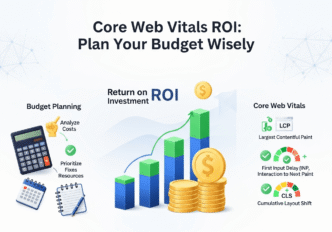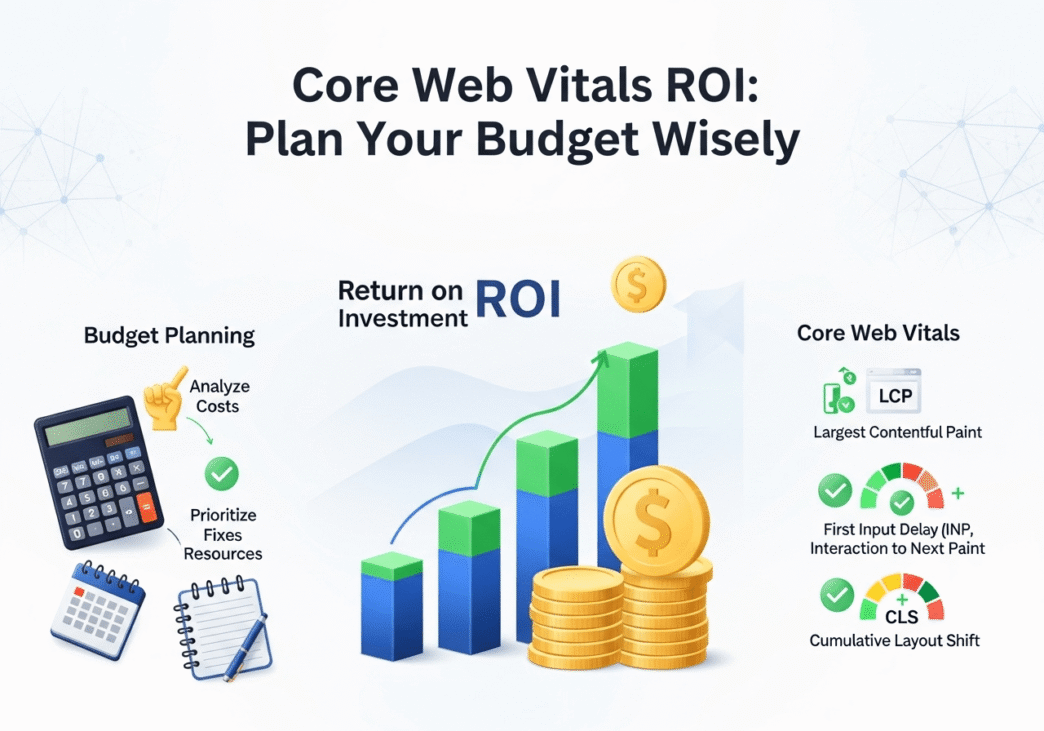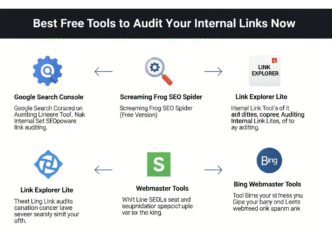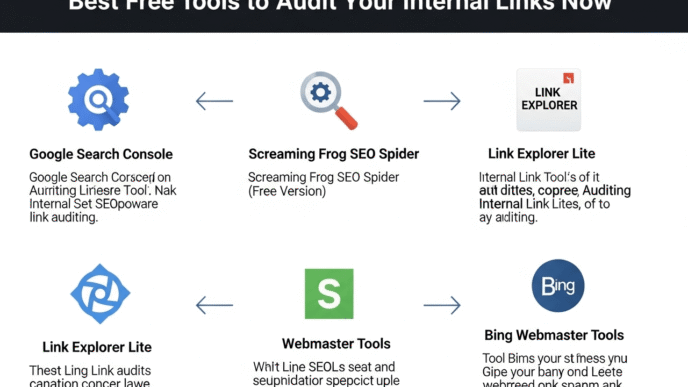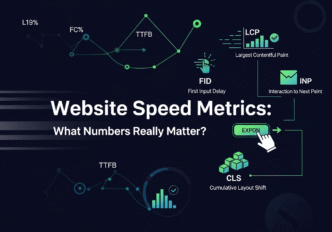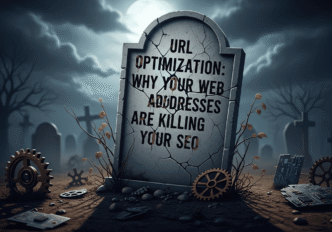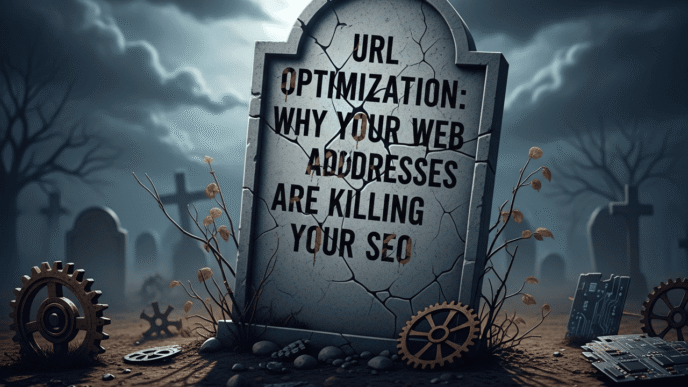Your boss just asked you to justify spending $50,000 on website performance optimization. You know Core Web Vitals are important, but how do you explain to someone who thinks “the website looks fine on my computer” that speed optimization could literally transform your business?
Welcome to the world of Core Web Vitals ROI, where proving the value of performance improvements can feel like explaining quantum physics to a golden retriever. It’s frustrating because you know the benefits are real, but translating milliseconds into dollars requires some serious number crunching.
Here’s the good news: performance investment has some of the most measurable and predictable returns in digital marketing. Unlike SEO or content marketing where results can be fuzzy, Core Web Vitals ROI provides clear, trackable metrics that directly correlate with business outcomes. Ready to build a bulletproof business case for performance optimization?
Table of Contents
ToggleWhat Is the Real ROI of Core Web Vitals Optimization?
Core Web Vitals ROI varies dramatically by industry, but the pattern is consistent: faster sites make more money. It’s like the difference between a sports car and a horse-drawn carriage – both will get you there, but one creates a significantly better experience.
The typical performance ROI breakdown looks like this:
- E-commerce sites: 15-40% revenue increase
- Lead generation: 20-50% conversion improvement
- Content/Media: 25-60% ad revenue boost
- SaaS platforms: 10-30% signup rate improvement
- Local businesses: 20-45% phone call increase
Performance optimization investment returns typically break even within 3-6 months and continue generating returns for years. Unlike paid advertising where you pay for each click, Core Web Vitals improvements keep delivering value 24/7.
Pro Tip: The ROI of Core Web Vitals optimization compounds over time. A 20% conversion rate improvement doesn’t just affect this month’s revenue – it impacts every visitor for years to come, making the long-term ROI potentially astronomical.
How Much Does Core Web Vitals Optimization Cost?
Understanding Core Web Vitals optimization cost is crucial for optimization budget planning. Costs vary based on site complexity, current performance level, and optimization approach:
| Optimization Level | Cost Range | Timeline | Expected ROI | Best For |
|---|---|---|---|---|
| DIY Basic | $500-2,000 | 2-4 weeks | 300-600% | Small businesses |
| Professional | $5,000-15,000 | 1-3 months | 400-800% | Medium businesses |
| Enterprise | $25,000-100,000 | 3-6 months | 500-1200% | Large corporations |
| Ongoing Maintenance | $1,000-5,000/month | Continuous | 200-400% annually | All sizes |
Detailed Cost Breakdown by Component
Technical Optimization Costs:
- Image optimization: $500-2,000 (depending on catalog size)
- Code optimization: $2,000-8,000 (JavaScript/CSS improvements)
- Hosting upgrade: $100-1,000/month (performance-optimized hosting)
- CDN implementation: $50-500/month (content delivery network)
- Monitoring tools: $0-300/month (performance tracking)
Professional Services Costs:
- Performance audit: $1,000-5,000 (comprehensive site analysis)
- Implementation: $5,000-50,000 (depends on complexity)
- Ongoing optimization: $2,000-10,000/month (continuous improvement)
Pro Tip: Start with quick wins that cost under $2,000 but can deliver 30-50% performance improvements. These provide immediate ROI while building the business case for larger investments.
How to Calculate ROI of Performance Improvements?
Calculate ROI of performance improvements using this proven framework that turns technical metrics into business language:
The Core Web Vitals ROI Formula
Performance ROI = (Revenue Increase - Optimization Cost) / Optimization Cost × 100
Where Revenue Increase =
Baseline Revenue × Conversion Rate Improvement × Time Period
Step-by-Step ROI Calculation
Step 1: Establish Your Baseline
- Monthly website revenue: $100,000
- Monthly visitors: 50,000
- Current conversion rate: 2%
- Average order value: $100
Step 2: Project Performance Improvements Based on industry benchmarks:
- LCP improvement: 2s → 1.2s = 15% conversion boost
- FID improvement: 200ms → 80ms = 8% conversion boost
- CLS improvement: 0.25 → 0.05 = 12% conversion boost
- Combined improvement: ~35% conversion rate increase
Step 3: Calculate Revenue Impact
New conversion rate: 2% × 1.35 = 2.7%
Additional conversions: 50,000 × 0.007 = 350 per month
Additional revenue: 350 × $100 = $35,000 per month
Annual revenue increase: $35,000 × 12 = $420,000
Step 4: Factor in Optimization Costs
One-time optimization cost: $15,000
Annual maintenance: $12,000
Total first-year cost: $27,000
First-year ROI: ($420,000 - $27,000) / $27,000 = 1,456%
Advanced ROI Calculations
Lifetime Value Consideration: Performance improvements don’t just affect immediate conversions – they impact:
- Customer retention (faster sites have 25% higher retention)
- Repeat purchases (better UX leads to more loyalty)
- Word-of-mouth marketing (satisfied customers refer others)
- SEO improvements (better rankings from Core Web Vitals)
Pro Tip: Conservative ROI estimates often undervalue long-term benefits. Include SEO improvements, customer lifetime value increases, and reduced support costs in your calculations for a more complete picture.
What Factors Affect Core Web Vitals Budget Planning?
Core Web Vitals budget planning requires understanding variables that impact both costs and returns:
Site Complexity Factors
Simple Sites (5-20 pages):
- Optimization cost: $2,000-8,000
- Timeline: 2-6 weeks
- Expected ROI: 400-800%
- Key focus: Image optimization, basic caching
Medium Sites (20-500 pages):
- Optimization cost: $8,000-25,000
- Timeline: 6-12 weeks
- Expected ROI: 500-1000%
- Key focus: Code optimization, advanced caching, CDN
Large Sites (500+ pages):
- Optimization cost: $25,000-100,000+
- Timeline: 3-6 months
- Expected ROI: 600-1500%
- Key focus: Architecture optimization, custom solutions
Industry-Specific Considerations
| Industry | Performance Sensitivity | ROI Multiplier | Budget Priority |
|---|---|---|---|
| E-commerce | Very High | 1.5-2x | Mobile optimization |
| Finance | High | 1.3-1.8x | Security + performance |
| Healthcare | Medium-High | 1.2-1.6x | Accessibility compliance |
| Education | Medium | 1.1-1.4x | Content delivery |
| B2B SaaS | High | 1.4-1.9x | User experience |
Geographic and Audience Factors
Global Audience Considerations:
- CDN requirements: Higher costs but better international performance
- Multiple hosting regions: Increased complexity and costs
- Localization needs: Performance varies by market
Device Demographics:
- Mobile-heavy audiences: Prioritize mobile optimization budget
- Desktop users: Focus on advanced features and interactions
- Mixed usage: Balanced optimization approach
Real-World Case Study: Manufacturing Company’s Performance Investment
Let me share a compelling business case for Core Web Vitals investment:
The Challenge: A B2B manufacturing company with a $5M annual revenue website was losing leads due to poor mobile performance and slow quote request forms.
Initial Business Metrics:
- Monthly website visitors: 25,000
- Lead conversion rate: 1.2%
- Average deal value: $15,000
- Monthly leads: 300
- Monthly revenue from website: $450,000
Performance Baseline:
- LCP: 5.2 seconds (Poor)
- FID: 320ms (Poor)
- CLS: 0.28 (Poor)
- Mobile bounce rate: 73%
- Quote form abandonment: 68%
Investment Decision Process:
Month 1: ROI Analysis and Business Case
Projected Performance Improvements:
- LCP target: 1.8 seconds (expected 25% conversion improvement)
- FID target: 85ms (expected 15% conversion improvement)
- CLS target: 0.06 (expected 10% conversion improvement)
- Combined impact: ~50% conversion rate improvement
ROI Projection:
Current monthly leads: 300
Improved conversion rate: 1.2% × 1.5 = 1.8%
New monthly leads: 25,000 × 0.018 = 450
Additional leads: 150 per month
Additional revenue: 150 × $15,000 = $2.25M annually
Investment Plan:
- Performance audit: $3,000
- Technical optimization: $18,000
- Hosting upgrade: $2,400/year
- Monitoring tools: $1,800/year
- Total first-year cost: $25,200
Projected ROI: ($2,250,000 – $25,200) / $25,200 = 8,829%
Month 2-4: Implementation Phase
Optimization Strategy:
- Mobile-first redesign of quote request forms
- Image optimization for product catalogs
- Server-side optimization and hosting upgrade
- Progressive enhancement for complex product configurators
Investment Tracking:
- Week-by-week performance monitoring
- Lead quality assessment (not just quantity)
- Customer feedback on website experience
- Sales team input on lead qualification
Month 5-6: Results Analysis
Performance Improvements Achieved:
- LCP: 1.6 seconds (Good – 69% improvement)
- FID: 72ms (Good – 77% improvement)
- CLS: 0.04 (Good – 86% improvement)
- Mobile bounce rate: 45% (38% improvement)
- Quote form completion: 67% (45% improvement increase)
Business Results After 6 Months:
- Monthly leads: 485 (+62% increase)
- Lead quality score: +23% improvement
- Monthly revenue: $728,000 (+62% increase)
- Customer acquisition cost: -31% decrease
- Sales cycle length: -18% shorter
Actual ROI Calculation:
Additional annual revenue: $3,336,000
Total investment: $25,200
Actual ROI: 13,138%
Payback period: 0.27 months (8 days!)
Unexpected Benefits:
- SEO improvements: +45% organic traffic increase
- Sales team efficiency: Leads were more qualified and ready to buy
- Customer satisfaction: +67% improvement in website experience ratings
- Competitive advantage: Faster than 90% of industry competitors
Pro Tip: The most surprising result was how performance improvements enhanced their entire sales funnel. Better qualified leads led to shorter sales cycles, higher close rates, and increased deal values – multiplying the ROI beyond initial projections.
Performance Investment vs Other Marketing Channels
Website investment in Core Web Vitals often outperforms traditional marketing channels:
| Marketing Channel | Typical ROI | Payback Period | Ongoing Costs | Measurability |
|---|---|---|---|---|
| Core Web Vitals | 400-1500% | 1-6 months | Low | Very High |
| Google Ads | 200-400% | Immediate | High | High |
| SEO | 300-800% | 6-18 months | Medium | Medium |
| Content Marketing | 300-600% | 12-24 months | Medium | Medium |
| Social Media Ads | 150-300% | Immediate | High | Medium |
| Email Marketing | 400-700% | 1-3 months | Low | High |
Why Performance Investment Wins
Compounding Returns: Unlike paid advertising, Core Web Vitals improvements benefit every visitor forever.
Lower Ongoing Costs: After initial optimization, maintenance costs are minimal compared to continuous ad spend.
Multiple Benefit Streams:
- Direct conversion improvements
- SEO ranking benefits
- Reduced bounce rates
- Better customer experience
- Lower support costs
- Competitive differentiation
Cost of Core Web Vitals Optimization: Budget Allocation Framework
Cost of Core Web Vitals optimization should be allocated strategically across different improvement areas:
Recommended Budget Allocation
Image Optimization (25-30% of budget):
- Highest impact, lowest cost optimization
- Tools and services: $500-5,000
- Expected improvement: 30-50% LCP reduction
Code Optimization (30-40% of budget):
- JavaScript and CSS improvements
- Developer time: $3,000-20,000
- Expected improvement: 40-60% FID reduction
Hosting and Infrastructure (15-25% of budget):
- Server upgrades and CDN
- Monthly costs: $100-2,000
- Expected improvement: 20-40% overall performance
Monitoring and Maintenance (10-15% of budget):
- Tools and ongoing optimization
- Annual costs: $1,000-10,000
- Expected improvement: Prevents regression
Professional Services (varies):
- Audit, strategy, implementation
- Project costs: $5,000-50,000
- Expected improvement: Coordinated, expert optimization
ROI-Focused Budget Planning
Quick Wins (Month 1):
- Budget: 20% of total
- Focus: Image compression, basic caching
- Expected ROI: 300-500%
Foundation Improvements (Months 2-3):
- Budget: 50% of total
- Focus: Code optimization, hosting
- Expected ROI: 400-800%
Advanced Optimization (Months 4-6):
- Budget: 25% of total
- Focus: Custom solutions, fine-tuning
- Expected ROI: 200-400%
Ongoing Maintenance (Monthly):
- Budget: 5% of total monthly
- Focus: Monitoring, updates, new optimizations
- Expected ROI: 200-300% annually
Pro Tip: Allocate 20% of your Core Web Vitals budget for testing and experimentation. The highest ROI often comes from unexpected optimizations discovered during implementation.
Optimization Costs by Business Size and Type
Optimization budget recommendations by business category:
Small Business (Annual Revenue: $100K-1M)
Recommended Investment: $2,000-8,000 DIY vs Professional: 70% DIY, 30% professional help Timeline: 1-3 months Expected ROI: 400-800%
Budget Breakdown:
- Tools and plugins: $500-1,500
- Professional audit: $1,000-2,000
- Implementation help: $1,000-3,000
- Hosting upgrade: $500-1,500/year
Medium Business (Annual Revenue: $1M-10M)
Recommended Investment: $8,000-30,000 DIY vs Professional: 30% DIY, 70% professional Timeline: 2-4 months Expected ROI: 500-1000%
Budget Breakdown:
- Professional services: $5,000-15,000
- Tools and infrastructure: $2,000-8,000
- Hosting and CDN: $1,000-5,000/year
- Ongoing optimization: $2,000-7,000
Large Enterprise (Annual Revenue: $10M+)
Recommended Investment: $30,000-150,000 DIY vs Professional: 10% DIY, 90% professional Timeline: 3-8 months Expected ROI: 600-1500%
Budget Breakdown:
- Professional services: $20,000-80,000
- Custom development: $10,000-50,000
- Infrastructure: $5,000-20,000/year
- Ongoing optimization: $5,000-25,000/year
Performance Planning: Building Your Business Case
Performance planning requires a strategic approach to get budget approval:
Executive Summary Template
Problem Statement: “Our website’s poor Core Web Vitals scores are costing us [X]% in lost conversions and [Y]% in reduced SEO rankings, resulting in approximately $[Z] in lost annual revenue.”
Solution Overview: “Investing $[amount] in Core Web Vitals optimization will improve conversion rates by [X]%, increase organic traffic by [Y]%, and generate $[Z] in additional annual revenue.”
ROI Projection: “Expected ROI of [X]% with payback period of [Y] months, compared to [comparison with other marketing channels].”
Risk Mitigation
Common Concerns and Responses:
“The website works fine for me”
- Response: Show real user data from Google Analytics and Search Console
- Present mobile vs desktop performance differences
- Demonstrate competitor performance advantages
“Can’t we just buy more ads instead?”
- Response: Compare ongoing ad costs vs one-time optimization investment
- Show how performance improvements make all marketing more effective
- Demonstrate compound returns over time
“What if the improvements don’t work?”
- Response: Present industry case studies and performance guarantees
- Propose phased implementation with measurable milestones
- Offer performance monitoring and adjustment plans
Pro Tip: Frame Core Web Vitals investment as revenue protection rather than just revenue growth. Calculate how much money you’re losing to poor performance – it’s often more compelling than growth projections.
Performance ROI Measurement and Tracking
Performance ROI tracking requires the right metrics and tools:
Key Performance Indicators (KPIs)
Primary Revenue Metrics:
- Conversion rate changes (most important)
- Average order value impact
- Revenue per visitor improvement
- Customer lifetime value enhancement
Supporting Performance Metrics:
- Core Web Vitals scores (LCP, FID/INP, CLS)
- Page load times across devices
- Bounce rate improvements
- User engagement metrics
Business Impact Metrics:
- SEO ranking improvements
- Organic traffic growth
- Customer satisfaction scores
- Support ticket reduction
ROI Tracking Tools and Setup
// Performance ROI tracking implementation
class PerformanceROITracker {
constructor() {
this.baselineMetrics = this.getBaseline();
this.trackConversions();
this.trackPerformance();
}
trackConversions() {
// Track conversion correlation with performance
gtag('event', 'conversion', {
performance_score: this.calculatePerformanceScore(),
page_load_time: this.getPageLoadTime(),
device_type: this.getDeviceType()
});
}
calculateROI() {
const currentMetrics = this.getCurrentMetrics();
const improvement = {
conversionRate: (currentMetrics.conversions / currentMetrics.visitors) -
(this.baselineMetrics.conversions / this.baselineMetrics.visitors),
revenue: currentMetrics.revenue - this.baselineMetrics.revenue
};
return {
revenueIncrease: improvement.revenue,
roi: (improvement.revenue / this.optimizationCost) * 100,
paybackPeriod: this.optimizationCost / (improvement.revenue / 12)
};
}
}
The Future of Performance Investment
Website investment in performance will become even more critical:
Emerging Trends
AI-Powered Optimization:
- Automated performance improvements
- Predictive optimization based on user behavior
- Real-time adaptation to device capabilities
Performance as Competitive Advantage:
- Speed differentiation in saturated markets
- Performance guarantees as marketing tools
- User experience as primary ranking factor
Advanced ROI Measurement:
- Real-time ROI tracking
- Predictive performance impact modeling
- Multi-channel attribution for performance improvements
Pro Tip: The companies investing in Core Web Vitals optimization now will have a significant competitive advantage as performance expectations continue to rise and Google’s algorithm increasingly rewards fast sites.
Your Core Web Vitals ROI Action Plan
Ready to maximize your Core Web Vitals ROI? Here’s your budget-smart roadmap:
Phase 1: Business Case Development (Week 1)
- Calculate current performance impact on revenue
- Research industry benchmarks for improvement potential
- Estimate optimization costs based on site complexity
- Project ROI using conservative assumptions
- Prepare executive presentation with clear business case
Phase 2: Quick Wins Implementation (Weeks 2-4)
- Start with low-cost, high-impact optimizations
- Track immediate results to validate projections
- Document improvements for stakeholder reporting
- Build momentum for larger investments
Phase 3: Strategic Optimization (Months 2-4)
- Implement comprehensive optimization strategy
- Monitor ROI metrics weekly
- Adjust strategy based on results
- Scale successful optimizations
Phase 4: Continuous Improvement (Ongoing)
- Maintain performance with regular monitoring
- Optimize new content and features
- Track long-term ROI trends
- Plan future performance investments
Remember, Core Web Vitals ROI isn’t just about immediate returns – it’s about building a foundation for sustainable growth. Fast websites don’t just convert better today; they create loyal customers, improve SEO rankings, and provide competitive advantages that compound over time.
The smartest performance investment you can make is starting now. Every day you delay optimization is revenue left on the table and competitive advantage given to faster competitors.
Want to dive deeper into the technical aspects that drive these impressive returns? Understanding Core Web Vitals fundamentals will help you make more informed investment decisions and maximize your optimization ROI.
What’s your biggest challenge in getting budget approval for performance optimization? Share your ROI success stories or approval struggles in the comments below!

